Buddhist Crisis
The Buddhist Crisis, coined by Ambassador Lodge and the international press, was a months long public dissention instigated by radical factions who infiltrated South Vietnam and inflamed the already volatile political climate in this struggling Southeast Asian country [Blair, 1995].
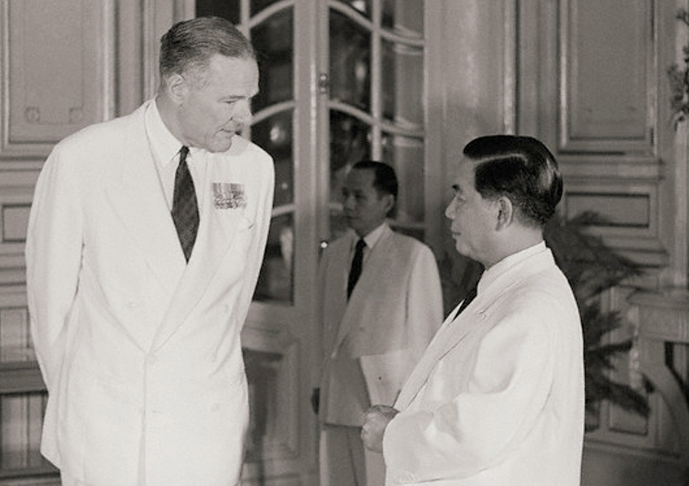 The United States grew uneasy when international media reported that political unrests continued to escalate, while South Vietnam President insisted that his administration was making progress toward quelling public dissension [Hammer, 1987]. While the first, opened coup by the military failed and the government jailed several key military members, it was non-violent and there was no loss of life. The next attempt was more secretive and deadly, as the President and his advisor were brutally murdered in Saigon, amidst conflicted reportings from the U.S. Embassy, Associated Press and South Vietnamese government themselves [Dommen, 2001]. The Military Junta effectively blocked off all troops loyal to the President and released several versions of the coup to the United States. First, the President and his advisor were caught in a tunnel, dressing as Catholic priests, then they committed suicide in their
escape car when the revolutionary forces were closing in. It was later changed to the brothers were killed by mortars upon attempting to escape the barricade of armored vehicles. The final official version indicated that both the Ngo brothers were killed by commandos [Dommen, 2001], [Hammer, 1987]. Even the media spared no mercy when publishing the late president's obituaries [Higgins, 1965], [Hammer, 1987].
While the second coup resulted in the violent ouster of South Vietnam first President, it was the subsequent turmoils that led to the Trial of Dang Sy and further escalations that caused the downfall of the Military Junta [Blair, 1995], [Hammer, 1987]. The United States grew uneasy when international media reported that political unrests continued to escalate, while South Vietnam President insisted that his administration was making progress toward quelling public dissension [Hammer, 1987]. While the first, opened coup by the military failed and the government jailed several key military members, it was non-violent and there was no loss of life. The next attempt was more secretive and deadly, as the President and his advisor were brutally murdered in Saigon, amidst conflicted reportings from the U.S. Embassy, Associated Press and South Vietnamese government themselves [Dommen, 2001]. The Military Junta effectively blocked off all troops loyal to the President and released several versions of the coup to the United States. First, the President and his advisor were caught in a tunnel, dressing as Catholic priests, then they committed suicide in their
escape car when the revolutionary forces were closing in. It was later changed to the brothers were killed by mortars upon attempting to escape the barricade of armored vehicles. The final official version indicated that both the Ngo brothers were killed by commandos [Dommen, 2001], [Hammer, 1987]. Even the media spared no mercy when publishing the late president's obituaries [Higgins, 1965], [Hammer, 1987].
While the second coup resulted in the violent ouster of South Vietnam first President, it was the subsequent turmoils that led to the Trial of Dang Sy and further escalations that caused the downfall of the Military Junta [Blair, 1995], [Hammer, 1987].
Ambassador Nolting called this brief, yet volatile period, the Buddhist Upheaval [Nolting, 1988] while the United Nations fact finding mission called it the Buddhist Revolt [United Nations, 1964].
When does justice become tyranny justice? Why did movements for justice often go wrong? To start with, the Buddhist Revolt was a contrived, cold-blooded political move organized under an organized "General Association of Vietnamese Buddhists" who sounded as if they
represented all the Buddhists in the country, but in fact it didn’t, not by a long shot.
Their political agitation was widely interpreted by Vietnamese and Americans as a revolt against religious persecution, just as they intended.
In fact, there was no religious persecution on the part of the government, or even religious discrimination.
This political plot to undermine the First Republic got a false interpretation in the U.S. press where it was sensationalized and badly misread, thus misled the American public on this crucial issue [Hasdorff, 2003].
Where do these information come from? Most of these came from the Military Junta, who sought to discredit the First Republic and to justify their actions to save South Vietnam from the political crisis [Moyar, 2006], [Jacobs, 2004].
To understand the cause of this situation, one needs to examine the beginning of this small country. The end of French colonial rule in Indochina marked the beginning of the United States effort to create a separate and strong state in Vietnam. The purpose of this nation building was to thwart Communist expansion. The United States would measure success by the Vietnamese government's ability to incorporate all elements of society into the new state. The Saigon regime repeatedly experienced great difficulty in commanding the allegiance of South Vietnam's Buddhists; these events were known as the Buddhist Crisis which cummulated into the downfall of President Diệm and the following regimes [Moyar, 2006].
South Vietnam’s origins can be traced to the French colony of Cochinchina, a subdivision of French Indochina, which consisted of the southern third of Vietnam. After World War II, the Việt Minh, a combination of nationalists and communists, commanded by General Võ Nguyên Giáp, forced the Imperial French to surrender and Vietnam gained independence [Moyar, 2006]. In 1949, the Geneva Convention held in Paris divided Vietnam at the 17th Parallel. The North, led by Hô Chi Minh and the South, led by Emperor Bảo Đại.
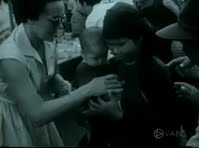 In 1954, a mass exodus of people from the North fled the extreme socialist policies and land reforms of the communist government [Moyar, 2006]. For those who had no where to go, Prime Minister Ngô Đình Diệm relocated them just outside of Saigon, with the purpose of re-integrating them into the new southern environment and culture. In 1955, Emperor Bảo Đại abdicated and the first democratic election was set up to select the next leader.
In 1954, a mass exodus of people from the North fled the extreme socialist policies and land reforms of the communist government [Moyar, 2006]. For those who had no where to go, Prime Minister Ngô Đình Diệm relocated them just outside of Saigon, with the purpose of re-integrating them into the new southern environment and culture. In 1955, Emperor Bảo Đại abdicated and the first democratic election was set up to select the next leader.
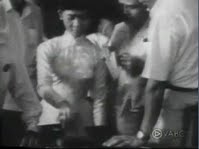 Though North Vietnam contested the election as being rigged, Prime Minister Ngô Đình Diệm received more popular votes than other candidates such as House Delegate Trần Văn Hương. South Vietnam held elections for the General Assembly, which constituted all citizens, regardless of religions or political affiations [Moyar, 2006]. Within a few years, South Vietnam production per capita grew both economically and socially. An average person annual earning was equivalent to $130 (USD) while production of sugar, rice and seafood doubled. Saigon grew into an international hub and dubbed "Pearl of the Far East" [Gheddo, 1970]. With economic helps from the United States, the First Republic embarked on various successful, non-violent land reforms that eliminated land serfdom from the monarchaic days, by purchasing lands from landowners and distributed them to working peasants. This won large majority people over, especially those who had experienced the violent and unjust land confistications practices from the North. The program lasted until funds eventually dried out [Moyar, 2006]. The Human Border Initiative was another successful program to bring roads and military support to remote areas in Central Vietnam. The First Republic opened roads from cities to outskirt areas to strengthen towns security with frequent troops patrols and better business commerce [Moyar, 2006].
Though North Vietnam contested the election as being rigged, Prime Minister Ngô Đình Diệm received more popular votes than other candidates such as House Delegate Trần Văn Hương. South Vietnam held elections for the General Assembly, which constituted all citizens, regardless of religions or political affiations [Moyar, 2006]. Within a few years, South Vietnam production per capita grew both economically and socially. An average person annual earning was equivalent to $130 (USD) while production of sugar, rice and seafood doubled. Saigon grew into an international hub and dubbed "Pearl of the Far East" [Gheddo, 1970]. With economic helps from the United States, the First Republic embarked on various successful, non-violent land reforms that eliminated land serfdom from the monarchaic days, by purchasing lands from landowners and distributed them to working peasants. This won large majority people over, especially those who had experienced the violent and unjust land confistications practices from the North. The program lasted until funds eventually dried out [Moyar, 2006]. The Human Border Initiative was another successful program to bring roads and military support to remote areas in Central Vietnam. The First Republic opened roads from cities to outskirt areas to strengthen towns security with frequent troops patrols and better business commerce [Moyar, 2006].
Confucian has been in Vietnam since the begining of history; influenced by Chinese culture, Vietnamese practiced ancestral worship. About 90% of Vietnamese worshipped their ancestors. Buddhism was introduced later and was most flourished under the Tran Dynasty during the 15th century. Buddhist pagodas were erected in honor of Kings and nobles. The king granted lands to build temples. Being a newer religion, the Catholic establishments were incorporated in the late 19th century. Under President Diệm, Catholics were appointed to positions of power at all levels of government. The Buddhists, who constituted a majority of Vietnamese, resented the preferential treatment given to the small Catholic minority in South Vietnam and those migrated from the North, they viewed Catholism generally enjoyed advantages throughout South Vietnamese society since the French colonism through the early days of the First Republic [Blair, 1995]. The late 1950s and early 1960s witnessed a growth in Buddhist
institutions in the South, both secular and religious. The desire to gain influence in proportion to their numbers led to the emergence of a Buddhist community with a high level of political and social consciousness [Brush, 2005].
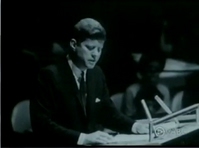 In April 1961, a treaty of amity and economic relations was signed with South Vietnam, and in December, President John F. Kennedy pledged to help South Vietnam maintain its independence. Subsequently, U.S. economic and military assistance to the First Republic increased significantly. In December 1961, the first U.S. troops, consisting of 400 uniformed army personnel, arrived in Saigon in order to operate two helicopter companies; these were non-combat units. A year later, U.S. military strength in Vietnam stood at 11,200 [Onion, Sullivan, Mullen, 2009].
While top level U.S. government was given good progresses made in South Vietnam, people on the grounds in Saigon did not believe in such outcomes.
Starting with the attempted assasination of Ngo Dinh Nhu in 1959 with an unknown explosive device, and a failed military coup in 1960, the First Republic had been internally and external subverted [Hammer, 1987].
According to the United Nations Fact Finding Mission report, both Buddhist and Catholic organizations chose to display their many religious flags in their pagodas and churches during their
celebration, while the national flag was underrepresented. At a time when North Vietnam's agression surged, President Diem noticed that National pride seemed to take secondary place to
religious and political belief. The Department of Interior was to pass a law that would emphasize unity in South Vietnam, requiring people displayed their national pride by rallying behind the national flag, then showed their freedom of religion with their various religious flags and symbols.
This law was to be enacted in 1963, just before the Catholic celebration of the Feast of Ascension and the Buddhist celebration of Buddha birthday, which no one seemed to be concerned that it would be used for political purposes of purporting the First Republic in a negative light [United Nations, 1964].
By the time the international media had become a negative maelstrom from the pressure of Germany and France, the architect of the 1949 Geneva Convention, the political climate in Washington toward South Vietnam had became toxic [Hasdorff, 2003].
Madame Nhu, in her final trip to the United States (Vietnamese: Chuyến Đi Dãi Độc), with her messages of women liberation and South Vietnam progress,
was being taken by the press under much negative light, as the United States foreign policies started South Vietnam toward a dangerous path [Hasdorff, 2003].
In April 1961, a treaty of amity and economic relations was signed with South Vietnam, and in December, President John F. Kennedy pledged to help South Vietnam maintain its independence. Subsequently, U.S. economic and military assistance to the First Republic increased significantly. In December 1961, the first U.S. troops, consisting of 400 uniformed army personnel, arrived in Saigon in order to operate two helicopter companies; these were non-combat units. A year later, U.S. military strength in Vietnam stood at 11,200 [Onion, Sullivan, Mullen, 2009].
While top level U.S. government was given good progresses made in South Vietnam, people on the grounds in Saigon did not believe in such outcomes.
Starting with the attempted assasination of Ngo Dinh Nhu in 1959 with an unknown explosive device, and a failed military coup in 1960, the First Republic had been internally and external subverted [Hammer, 1987].
According to the United Nations Fact Finding Mission report, both Buddhist and Catholic organizations chose to display their many religious flags in their pagodas and churches during their
celebration, while the national flag was underrepresented. At a time when North Vietnam's agression surged, President Diem noticed that National pride seemed to take secondary place to
religious and political belief. The Department of Interior was to pass a law that would emphasize unity in South Vietnam, requiring people displayed their national pride by rallying behind the national flag, then showed their freedom of religion with their various religious flags and symbols.
This law was to be enacted in 1963, just before the Catholic celebration of the Feast of Ascension and the Buddhist celebration of Buddha birthday, which no one seemed to be concerned that it would be used for political purposes of purporting the First Republic in a negative light [United Nations, 1964].
By the time the international media had become a negative maelstrom from the pressure of Germany and France, the architect of the 1949 Geneva Convention, the political climate in Washington toward South Vietnam had became toxic [Hasdorff, 2003].
Madame Nhu, in her final trip to the United States (Vietnamese: Chuyến Đi Dãi Độc), with her messages of women liberation and South Vietnam progress,
was being taken by the press under much negative light, as the United States foreign policies started South Vietnam toward a dangerous path [Hasdorff, 2003].
The First Republic, meanwhile, had to deal with Communist aggression from the North and to cope with growing unrest among South Vietnamese Buddhists and other religious groups.
 As the military influences and discontents grew stronger in the government, the First Republic implemented Strategic Hamlets, a successful program to control insurgents [Moyar, 2006]. Unfortunately, this accomplishment from the civilian side of the government grew pale in comparison to anti-government agitation among the Buddhists that was especially strong. The notable incident was the killings of demonstrators at a state run radio station in Hue, central Vietnam. According to the U.S. Consulate at Hue to Washington, DC, there were 2 incidents that caused civilian lives. One happened at the porch of the radio station and another somewhere outside the radio station [U.S. Department of State, 1963].
As the military influences and discontents grew stronger in the government, the First Republic implemented Strategic Hamlets, a successful program to control insurgents [Moyar, 2006]. Unfortunately, this accomplishment from the civilian side of the government grew pale in comparison to anti-government agitation among the Buddhists that was especially strong. The notable incident was the killings of demonstrators at a state run radio station in Hue, central Vietnam. According to the U.S. Consulate at Hue to Washington, DC, there were 2 incidents that caused civilian lives. One happened at the porch of the radio station and another somewhere outside the radio station [U.S. Department of State, 1963].
 The government charged that the Buddhist groups had become infiltrated by politically hostile persons, including Communists. This contention was supported by outside observers, including a U.S. fact-finding team [Onion, Sullivan, Mullen, 2009], [Hammer, 1987], [United Nations, 1964].
With the burning death of a revered Buddhist monk, massive media campaign of alleged Buddhist persecution, arrests of Buddhist radicals who attempted self-immolation in Saigon,
Hue Radio Station incident, further arrests of Buddhist radicals in Hue, the government takeover of main pagodas in Saigon, and other unfriendly remarks toward the Buddhists to the Associated Press by Madame Nhu, the First Republic was engulfed in media storms. The New York Times printed editorials from Reverend Donald Harrington and Dr. Erich Wulf indicated the First Republic persecuted the larger Buddhist populations through excessive military forces and oppressive policies. Drs. Harrington and Wulf claimed that Catholic Church in Vietnam obtained U.S. fundings to build universities and oppressed Buddhists [Harrington, July 1963], [Wulff, August 1963]. These were refuted with other editorials from Reverend Patrick O'Connor. While Dr. Harrington was in the United States, Dr. Wulff was in Vietnam for two years.
The government charged that the Buddhist groups had become infiltrated by politically hostile persons, including Communists. This contention was supported by outside observers, including a U.S. fact-finding team [Onion, Sullivan, Mullen, 2009], [Hammer, 1987], [United Nations, 1964].
With the burning death of a revered Buddhist monk, massive media campaign of alleged Buddhist persecution, arrests of Buddhist radicals who attempted self-immolation in Saigon,
Hue Radio Station incident, further arrests of Buddhist radicals in Hue, the government takeover of main pagodas in Saigon, and other unfriendly remarks toward the Buddhists to the Associated Press by Madame Nhu, the First Republic was engulfed in media storms. The New York Times printed editorials from Reverend Donald Harrington and Dr. Erich Wulf indicated the First Republic persecuted the larger Buddhist populations through excessive military forces and oppressive policies. Drs. Harrington and Wulf claimed that Catholic Church in Vietnam obtained U.S. fundings to build universities and oppressed Buddhists [Harrington, July 1963], [Wulff, August 1963]. These were refuted with other editorials from Reverend Patrick O'Connor. While Dr. Harrington was in the United States, Dr. Wulff was in Vietnam for two years.
 Father O'Connor was there considerably longer. Despite claims of religious favoritism, Catholic officers and generals occupied a fraction of overall census. Out of seventeen Cabinet members, only 5 were Catholics, out of nineteen generals, only four were Catholics; and out of fourteen special forces commanding officers, only four were Catholics. Buddhists did not have presence in armed forces chaplain because of their pacifist doctrines. Buddhist monks and nuns could not accompany troops to battle fields and could only function on certain days due to religious observance. The Catholic and Protestant chaplains; however, did not have such restrictions. Buddhists did not have special centers for leperosies or other infectious diseases. Catholic missions set up shelter centers for
indiginous people to Vietnam, collectively called Viet Toc. Four Catholic universities and numerous schools, operated in cities and remote areas in Vietnam, ran with donations from Catholic churches in Vietnam, and from Germany and the United States. These were chaired by non-Catholic state officials. Two state-run Buddhist universities, operated in Saigon, were under the Buddhist hierarchy control [O'Connor, July 1963], [O'Connor, August 1963].
As the First Republic shifted to harsher policies in dealing with Communism, nine millions piases, or $1.6 million USD, was diverted to build Buddhist temples to accomodate the Buddhist population growth of 32% [Gheddo, 1970].
Father O'Connor was there considerably longer. Despite claims of religious favoritism, Catholic officers and generals occupied a fraction of overall census. Out of seventeen Cabinet members, only 5 were Catholics, out of nineteen generals, only four were Catholics; and out of fourteen special forces commanding officers, only four were Catholics. Buddhists did not have presence in armed forces chaplain because of their pacifist doctrines. Buddhist monks and nuns could not accompany troops to battle fields and could only function on certain days due to religious observance. The Catholic and Protestant chaplains; however, did not have such restrictions. Buddhists did not have special centers for leperosies or other infectious diseases. Catholic missions set up shelter centers for
indiginous people to Vietnam, collectively called Viet Toc. Four Catholic universities and numerous schools, operated in cities and remote areas in Vietnam, ran with donations from Catholic churches in Vietnam, and from Germany and the United States. These were chaired by non-Catholic state officials. Two state-run Buddhist universities, operated in Saigon, were under the Buddhist hierarchy control [O'Connor, July 1963], [O'Connor, August 1963].
As the First Republic shifted to harsher policies in dealing with Communism, nine millions piases, or $1.6 million USD, was diverted to build Buddhist temples to accomodate the Buddhist population growth of 32% [Gheddo, 1970].
Although the majority of Buddhist did not take part directly, certain radical Buddhist leadership's opposition to the Saigon regime was responsible for the November 2, 1963, coup that overthrew and killed President Diệm [Brush, 2005], [Moyar, 2006].
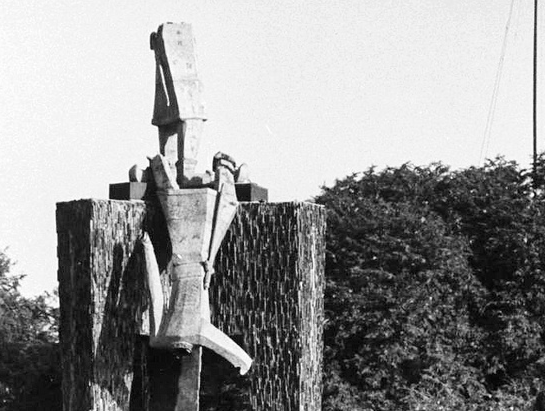 While many considered the Buddhist Crisis was over after the death of President Diem and the replacement of the First Republic, political unrests continued to swell further into the following years.
As the Military Junta took over, any landmarks resembling the First Republic were destroyed.
A notable event was the removal of the Trung Sisters statues in Saigon, a symbol of Vietnamese independence against Chinese imperialism started by two Vietnamese sisters, because it was deemed to honoring Madame Nhu and her daughter [Jacobs, 2004]. While many considered the Buddhist Crisis was over after the death of President Diem and the replacement of the First Republic, political unrests continued to swell further into the following years.
As the Military Junta took over, any landmarks resembling the First Republic were destroyed.
A notable event was the removal of the Trung Sisters statues in Saigon, a symbol of Vietnamese independence against Chinese imperialism started by two Vietnamese sisters, because it was deemed to honoring Madame Nhu and her daughter [Jacobs, 2004].
.jpg) It was the arrests and treatment of former government members that finally brought this tyranny of justice to the attention of the United States and the international communities. It was the arrests and treatment of former government members that finally brought this tyranny of justice to the attention of the United States and the international communities.
When the Military Junta quickly judged and executed Ngo Dinh Can and members of the former government, the United States intervened and demanded that the new South Vietnam government must provide due process and all legal venues to the accused prior to rendering judgment.
In 1964, the Revolutionary Council allowed the accused of the Hue Radio Station incident, Major Dang Sy, to be legally represented by a civilian. At the insistence from the United States, Major Dang should bear no political pressure to testify the truth about the late president and members of his family. The Trial of Dang Sy was closely monitored and followed by international press and the United Nations.
During the trial, the government leveled untrue charges and inconclusive evidences against Major Dang, while leaking allegations to to the media to sway international pubic opinions [Gheddo, 1970]. Despite the frame-up, the Military Tribunal could not render a guilty verdict under international guidelines,
and instead, handed indefinite confinement to Major Dang, away from the population, under a martial law enacted during the First Republic.
As the result from the findings at the trial, the accusations of religious prosecutions by the First Republic were repealed. The government had to release the remaining political prisoners, released confistications of properties, and restored military ranks to whomever applicable.
International pressure on the First Republic also eased up. People, who were not imprisoned but considered prominent during the First Republic years, were allowed to go abroad, of their own choices [Gheddo, 1970].
The Buddhist Crisis continued to ebb and flow until a new constitution was ratified by the Congress, thus the Second Republic was born.
In 1971, at the height of the Second Republic and when all religious sects and military factions consolidated, President Ngo Dinh Diem was declared a
National hero (Vietnamese: Vị Quốc Vong Thân). A large memorial site was built at Mạc Đĩnh Chi National Cemetery and on the eve of his death in November, Buddhist monks gathered to pray in Sanskrit chants and Roman Catholic clergies performed Latin mass, a pre-Vatican II mandate [Moyar, 2006].
Today, seeking to justify their places in history, some people ostentatiously referred to the Incident of May 8th, 1963 [U.S. Department of State, 1963], as the Hue Vesak Massacre or Hue chemical attack, that started the Buddhist Crisis.
They did not heed that the international communities were already aware of political unrests had started long before that.
These Wikipedia articles were based from the archived U.S. government documents and ironically used anti-Vietnam War authors to lend credence to debunked accusations brought up by the media at the time. These anti-war authors did not, by far, support the information provided by the documents archived by the Department of State. They sought the illigitimacy of the Vietnam War and how the Vietnam War could have been avoided. Wikipedia 's General Counsel announced in 2006 that the company had agressively stepping up its contents integrity by enforcing APA references and cited sources for any posted information.
These dishonorable articles did not serve the true purposes of the authors who were either pro-Vietnam War or anti-Vietnam War. While these politically or racially motivated campaigns certainly served as amusing, unsupported distractions aimed at South Vietnamese abroad dignity on public forums, they do not, in any way, change the realities that currently facing
the united Vietnam. Particularly, in the areas of war crimes, human rights, trafficking and national sovereignty with its ally and neighbor, China.
|